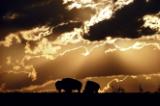A Brief History of Conservation Planning
A Brief History of Conservation Planning
18th-century European scientists were among the first voices to call for the conservation of natural resources and protection of valuable landscapes from over-exploitation. Their efforts focused both on the few remaining wild areas in Europe, such as Poland, and on the European colonies, especially tropical islands such as Mauritius, Tobago, and St. Vincent (Grove 1992). The main threat that these efforts sought to combat was deforestation; the voices of scientists helped lead to the establishment of forest reserves.
The modern land protection movement began on a meaningful scale in 1872, when Yellowstone became the world’s first national park. Scientists were not strongly involved in these planning efforts. The intent in establishing Yellowstone and other early national parks was not to conserve ecosystems, biodiversity, or even primarily wildlife – it was to preserve or “monumentalize” the scenic wonders of nature (Runte 1997). It was also an economic strategy: the beginning of destination tourism as we know it today, and an activity strongly promoted by the railroad industry and other sponsors. Similarly, wilderness areas on federal lands were established for their scenic values and to provide backcountry recreational opportunities. They have generally been established in high-elevation site and other areas with low potential for economic exploitation such as logging. Hence, conservation areas in the United States and most other countries were not selected using scientific data and methodologies and do a poor job at representing natural diversity (Scott et al. 2001).
Concerted involvement of scientists in conservation planning in North America began in the early 20th century with Victor Shelford and colleagues in the Ecological Society of America (ESA). Among Shelford’s goals, endorsed by the ESA, was “a nature sanctuary with its original wild animals for each biotic formation” in the Americas. Their efforts eventually led to the establishment of The Nature Conservancy (TNC) in 1950. TNC has since become the largest conservation land-acquisition organization in the world. NatureServe spun off from TNC in 1994 and subsequently became the umbrella organization for state, provincial, and national natural heritage programs (aka Conservation Data Centers) in most of the Western hemisphere. Today, NatureServe maintains a comprehensive web-based database on biodiversity, accessible through NatureServe Explorer.
Early prioritization efforts by ESA, TNC, and other groups were guided by expert opinion -- that is, ecologists familiar with a region would typically look at maps and pool their ideas about which areas needed to be protected. It was not until Ian McHarg’s Design with Nature book in 1969, the subsequent invention and rapid growth of geographic information systems (GIS), and the later development of mathematical algorithms for prioritization that conservation planning became rigorous and truly systematic. Today, the leading professional organization for conservation planners and conservation biologists generally is the Society for Conservation Biology, which was founded in 1985 and today contains more than 10,000 members around the world. For professionals particularly interested in GIS-based conservation planning, another key organization is the Society for Conservation GIS, which “assists conservationists worldwide in using GIS through communication, networking, scholarships, and training”:
The history of open-space planning in North America extends back to the early 20th century. According to Benedict and McMahon (2006), the roots of this movement can be found in two key concepts: (1) linking parks and other green spaces for the benefit of people, and (2) preserving and linking natural areas to benefit biodiversity and counter habitat fragmentation. However, the history of the open space movement reflects an emphasis on the first of these two concepts. Frederick Law Olmsted, a landscape architect and pioneer of public open space protection during the second half of the 19th century, believed that “no single park, no matter how large and how well designed, would provide the citizens with the beneficial influences of nature.” Instead, Olmsted insisted that parks need “to be linked to one another and to surrounding residential neighborhoods.” His idea of creating a linked network of parks for the recreational benefit of people evolved into the modern greenways movement: http://en.wikipedia.org/wiki/Greenway_(landscape).
Another important early figure in the open space protection movement was Benton MacKaye, who originated the idea of the Appalachian Trail. MacKaye, who was also very concerned about urban sprawl, described in “The New Exploration: A Philosophy of Regional Planning” (1928) how open space could be used to control development. MacKaye described an ideal community where “The outstanding topographic feature consists of the range of hills and mountains encircling the locality, together with the four ridges reaching toward the central city. This could be reserved as a common public ground, serving the double purpose of a public forest and a public playground” (cited in Benedict and McMahon).
Land trusts have sprung up all over the United States (as well as other countries) to preserve open space. The largest and most influential open space land trust is the Trust for Public Land. According to this web site, since 1972 “TPL has worked with willing landowners, community groups, and national, state, and local agencies to complete more than 3,500 land conservation projects in 47 states, protecting 2.5 million acres. Since 1994, TPL has helped states and communities craft and pass over 330 ballot measures, generating almost $25 billion in new conservation-related funding.” Another key organization, the Land Trust Alliance, serves as an umbrella group for local land trusts.
Go Straight to Your State
Learn about conservation and open space in your state.


